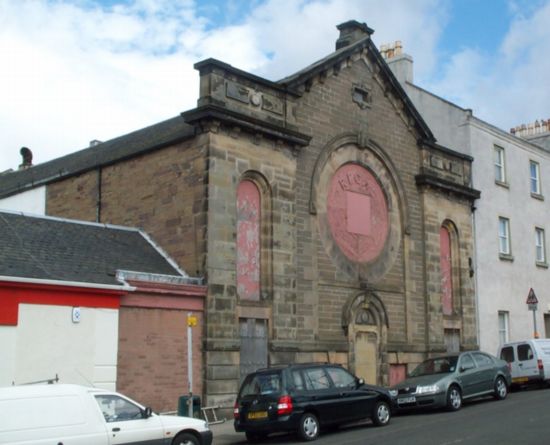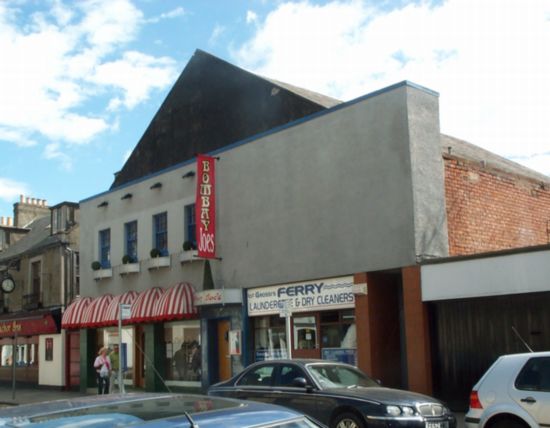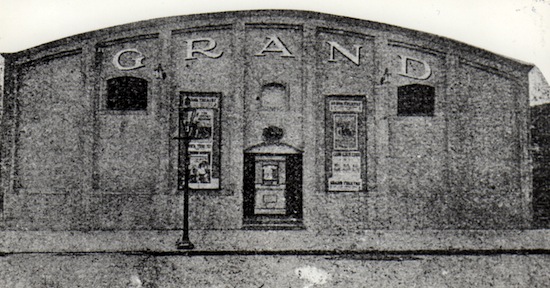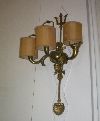|
Regal
51 Queen Street  This building has a complex history, and is quite a remarkable survivor even in its current heavily modified form.
Originally opened around 1870 as a hall for the First Forfarshire Artillery Volunteers, the entrance was through a symmetrical sandstone gable on Church Street, the most striking feature of which was a large circular window in the centre above the door. The interior at this point was a fairly narrow, tall space, but well decorated, with plain pilasters on the side walls being topped by elaborate gilt Corinthian capitals and lion head bosses. Decorated beams in the ceiling ran from above each pilaster to the matching pilaster opposite, and a foliate cornice and rectangular inlaid panels provided a diagonal transition between wall and ceiling in between the pilasters. Many of the 1936 decorative additions came from a recently scrapped White Star ocean liner called the Homeric, which also provided the interior for the Rex cinema in Stonehouse the following year. Amazingly, both the Regal and the Rex have survived relatively intact in their current use as storage spaces, and the interior of both cinemas, which had similar seating capacities, makes for a fascinating comparison. Of particular interest are the identical two-lamp light fightings, with the White Star logo on each stem, and the diagonal square coffering of the Rex ceiling and the Regal balcony underside. Bingo was introduced at the Regal on a part-time basis in 1978, later becoming full-time before the building closed in 1991. The auditorium, although presently used as an overspill car showroom, has survived remarkably intact, and most of the Victorian and 1936 details are still in situ. The aforementioned two-lamp light fittings from the Homeric adorn the side walls, with many even still retaining their cloth shades, as do the elaborate three-lamp fittings, which are mounted with golden vertical tridents as backing plates - again, presumably salvaged from the ship. The proscenium has gilt fruit and ribbon motifs to either side, and musical instruments above, while larger deco lights still hang from the roof. Some seating survives in the balcony, and even the stalls rake is intact, despite having to hold cars rather than patrons these days! Sadly, the 1936 foyer of the Regal was demolished to allow this new use. The patterned foyer floor was not saved, but some of the Homeric's mahogany panels which lined it appear to survive in storage on-site, albeit under several layers of paint. The building was B-listed in 1990, and is open daily for perusal of the cars inside - surely the most interesting and unusual car showroom in Scotland today?
|
Picture House / Reres Cinema
Grey Street

o. c. 1918 by A Greig. s. 500. Sold to Arbroath Cinema Co, c.1930.
Renamed, 1952. Cl. c. 1962. Now restaurants and launderette.
Photos courtesy of Graham Kelly
An archive view of the exterior from an old postcard can be seen here.
New Grand Theatre
King Street

o. c. 1917 by P. Chambers. Cl. early 40s. Dem 1965; council housing.
Image courtesy of the Cinema Theatre Association Archive (Tony Moss Collection)
Back MainGrey Street

o. c. 1918 by A Greig. s. 500. Sold to Arbroath Cinema Co, c.1930.
Renamed, 1952. Cl. c. 1962. Now restaurants and launderette.
Photos courtesy of Graham Kelly
An archive view of the exterior from an old postcard can be seen here.
New Grand Theatre
King Street

o. c. 1917 by P. Chambers. Cl. early 40s. Dem 1965; council housing.
Image courtesy of the Cinema Theatre Association Archive (Tony Moss Collection)




